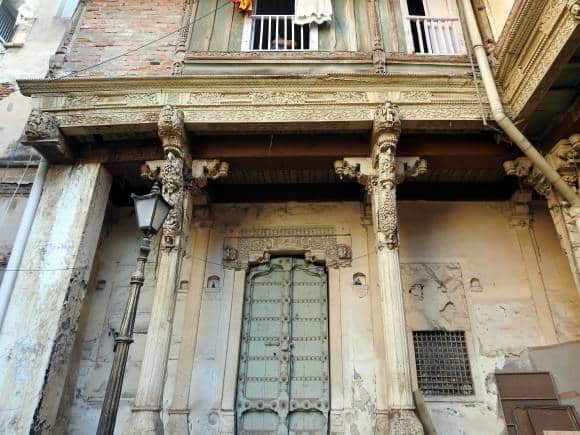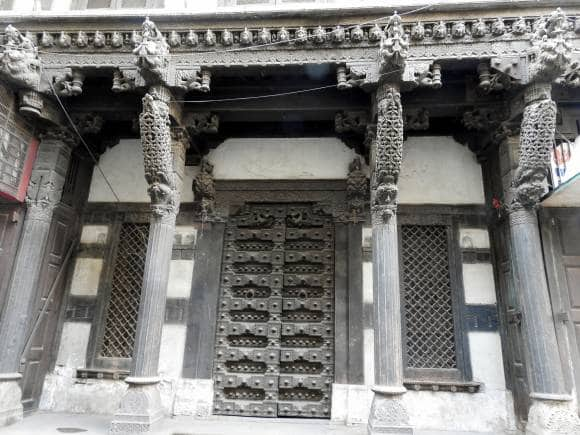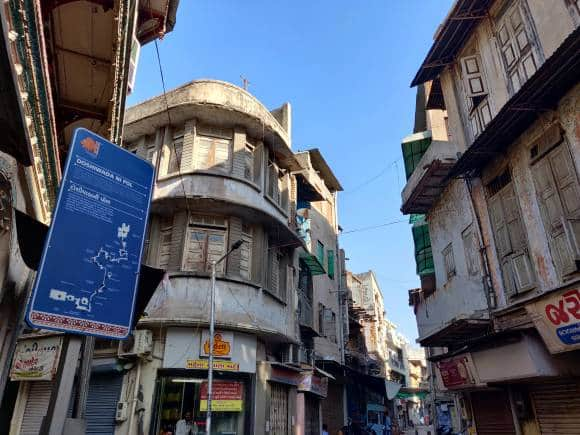



Australian Prime Minister Anthony Albanese's ongoing visit as well as the fourth Border Gavaskar Trophy Test match between India and Australia have again brought Ahmedabad in the spotlight. While the city has much to see and do, a guided morning heritage walk is great for insights into the city’s past. Here are the top 10 sites that you must not miss on your heritage trail as you navigate the city's many pols (or gates):
Swaminarayan Temple, KalupurBuilt in 1822, this is the world’s first Swaminarayan Temple. It has three sanctums and is a fine example of intricately wood-crafted architecture. The façade has motifs of flowers and figurines in brightly colours that instantly catch your eye. Most heritage tours start from this temple. Made with Burma teak wood, each arch and bracket is brightly coloured.
 Swaminarayan Temple. (Photo by Bindu Gopal Rao)Kavi Dalpatram Chowk
Swaminarayan Temple. (Photo by Bindu Gopal Rao)Kavi Dalpatram ChowkNamed after renowned Gujarati poet Kavi Dalpatram, this is his home that has been converted to the Dalpatram Memorial after the original house was destroyed.
 (Photo by Bindu Gopal Rao)
(Photo by Bindu Gopal Rao)The new home has been built using designs inspired by heritage homes in the vicinity, and a bronze statue of Kavi Dalpatram is also in the compound. Located at Lambeshwar Pol, the Chowk is used for community gatherings.
Calico DomeLocated on Relief Road, the Calico Dome once housed the Calico Mills started by the Sarabhai family in the 1880s. Inspired by Richard Buckminster Fuller's architectural designs, this is a geodesic dome that has a lattice-shell and is made using plywood. The dome collapsed in the 2001 earthquake and is being restored in phases.
 Partially collapsed Calico Dome. (Photo: Ahaana Kharawala via Wikimedia Commons 4.0)Kala Ramji Mandir
Partially collapsed Calico Dome. (Photo: Ahaana Kharawala via Wikimedia Commons 4.0)Kala Ramji MandirA temple that dates to the medieval times, the Kala Ramji Mandir has a black idol of Hindu God Ram. Part of a residential complex, the temple is at the end of the Haja Patel Ni Pol. The courtyard as well as brackets and columns here have fine carvings that are worth noticing. The deities themselves are unique as they are in seated position as opposed to the standing pose of Hindu God Ram that one normally sees.
 (Photo by Bindu Gopal Rao)Harkunvar Shethani ni Haveli
(Photo by Bindu Gopal Rao)Harkunvar Shethani ni HaveliSaid to be one the most ornate and grand havelis in Ahmedabad, Harkunvar Shethani ni Haveli is a stunning example of how a wood facade can be an integral architectural feature in a home. The three-storeyed double height haveli has 60 rooms done with traditional Gujrati woodwork. Keep your eye out for the carved bay balconies or jarokhas that are supported by large wood brackets, said to be one of their kind.
 (Photo by Bindu Gopal Rao)Kuvavala Khancho
(Photo by Bindu Gopal Rao)Kuvavala KhanchoIf you like observing architectural styles, especially of homes, the Kuvavala Khancho is a great place to see. This is near Shantinathji ni Pol, which has four homes, each of which has a different style of architecture. These are homes of affluent Gujarati businessmen who travelled abroad on work and came back to build houses inspired from their travels. A guide will point you to the styles European, Persian, Mughal, and Maratha.
 (Photo by Bindu Gopal Rao)Doshiwada ni pol
(Photo by Bindu Gopal Rao)Doshiwada ni polA locality where the goldsmith community resides, the main street here has all kinds of jewellery stores. When you walk here, you will notice several haveli homes that have magnificent facades with intricate carving. A carved Chabutara with stained glass at the end of this Pol is a great example of colonial influence on architecture. When here, look out for a landmark building that was once the tallest in the walled city.
 (Photo by Bindu Gopal Rao)Parrot holes & Chabutaras
(Photo by Bindu Gopal Rao)Parrot holes & ChabutarasAs you walk along the old city, it is impossible to miss how birds and humans have coexisted. Case in point are the decorated Chabutaras that are carved bird feeders as well as parrot holes in the exterior façades of buildings for parrots to stay. These were specifically built as there were few trees in the area and were made using leftover timber that was used to build homes.
 (Photo by Bindu Gopal Rao)Astapadji Derasar
(Photo by Bindu Gopal Rao)Astapadji DerasarThis Derasar or Jain Temple is in Doshiwada ni Pol and has the idols of the first Jain Tirthankar Bhagwan Adishvar and the 24th Jain Tirthankar Mahavir Swami. Step inside to see the 250-year-old multi-coloured marble and sandstone structure that was built in 1856 AD, by Sheth Maganlal Karamchand. Interestingly there is a rainwater harvesting system that was also built then and is being used for the water needs of the temple even today.
 (Photo by Bindu Gopal Rao)Jami Masjid
(Photo by Bindu Gopal Rao)Jami MasjidThe magnificent Jami Mosque once occupied a pride of place in the geographical layout and social life of the then newly built capital city of Ahmedabad and it is not hard to see why. Built by Sultan Ahmad Shah I in 1424, the mosque has been considered by scholars as one of the most beautiful in the East. The mosque has an extensive courtyard that has a spacious prayer hall that is partly closed and has a pillared hall as well. The prayer hall has 15 principal domes and 300 stone pillars, an architectural delight like no other.
 (Photo by Bindu Gopal Rao)
(Photo by Bindu Gopal Rao) Discover the latest Business News, Sensex, and Nifty updates. Obtain Personal Finance insights, tax queries, and expert opinions on Moneycontrol or download the Moneycontrol App to stay updated!
Find the best of Al News in one place, specially curated for you every weekend.
Stay on top of the latest tech trends and biggest startup news.